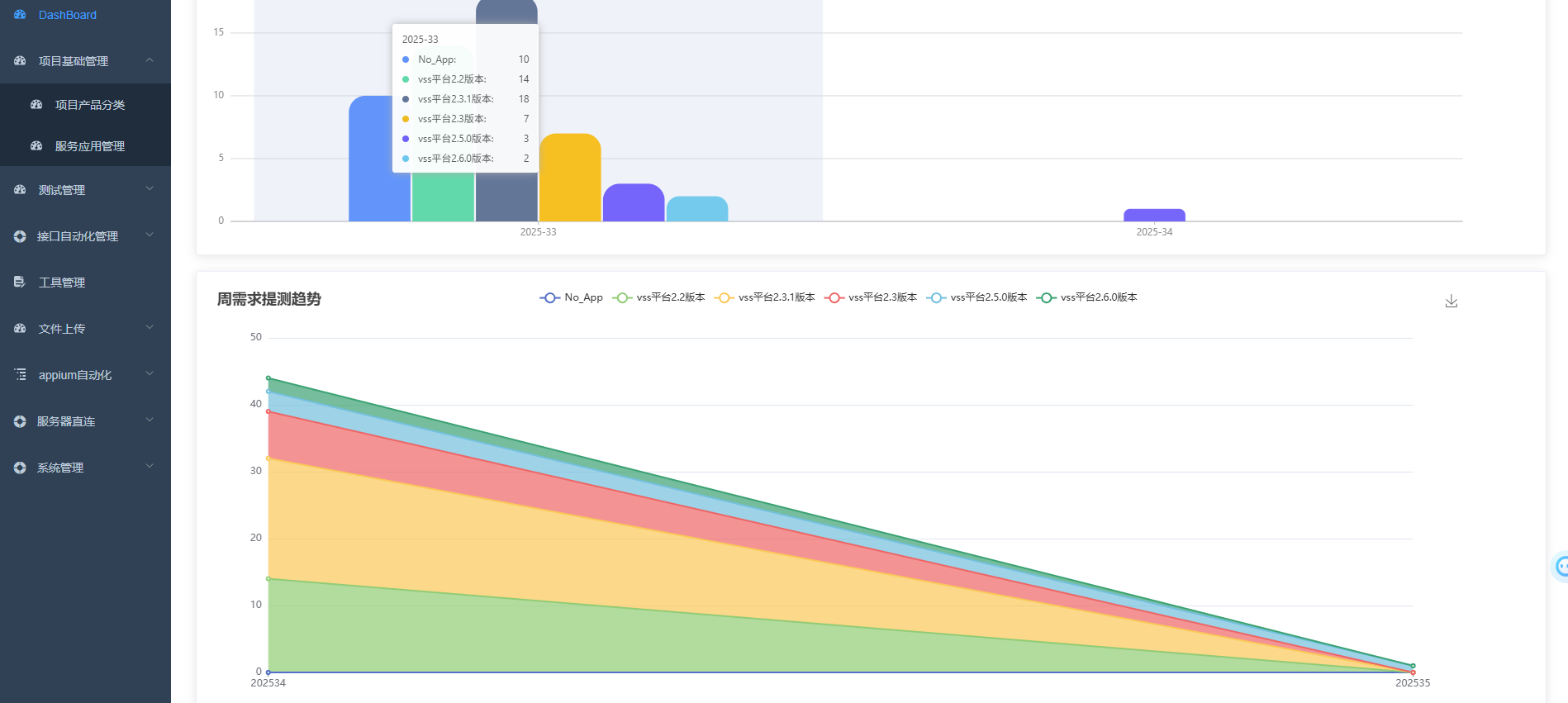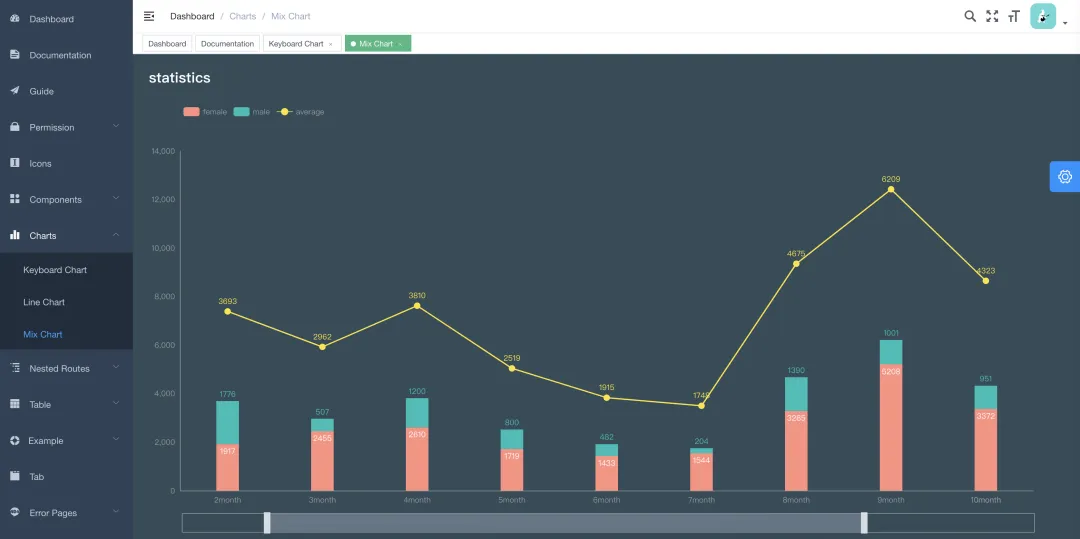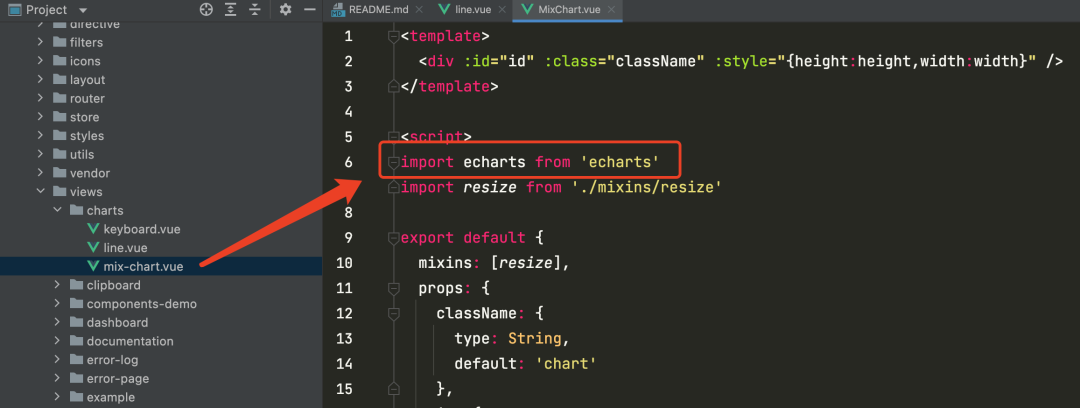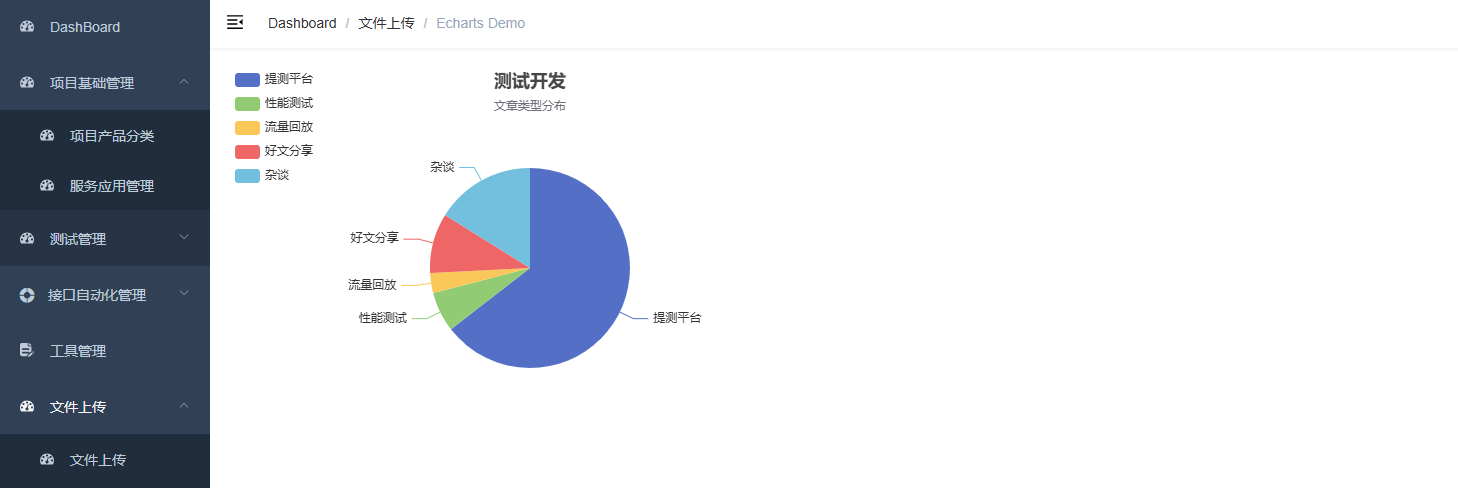概述:
在前面我们已经实现了我们的产品创建管理,应用管理管理,需求提测管理但是每周提测了多少需求,创建了哪些产品,我们是不是看着不是很直观,接下来我们就需要开发一个数据看板功能,实现能够看到产品下创建的需求,提测数据
先看看实现效果

后端接口源码:
# -*- coding:utf-8 -*-
# application.py
import datetime
import traceback
from flask import Blueprint, current_app
from dbutils.pooled_db import PooledDB
from apis.product import connectDB
from configs import config, format
from flask import request
import pymysql.cursors
import json
# from utils.jwt import login_required
# 使用数据库连接池的方式链接数据库,提高资源利用率
pool = PooledDB(pymysql, mincached=2, maxcached=5, host=config.MYSQL_HOST, port=config.MYSQL_PORT,
user=config.MYSQL_USER, passwd=config.MYSQL_PASSWORD, database=config.MYSQL_DATABASE,
cursorclass=pymysql.cursors.DictCursor)
test_dashboard = Blueprint("test_dashboard", __name__)
@test_dashboard.route("/api/dashboard/stacked", methods=['POST'])
def get_request_stacked():
connection = None
try:
connection = pool.connection()
with connection.cursor() as cursor:
sql_select = '''
SELECT DATE_FORMAT(request.createDate,"%Y%u") weeks,
apps.note,
COUNT(apps.id) counts
FROM request
LEFT JOIN apps ON request.appId = apps.id
GROUP BY weeks, apps.note;
'''
cursor.execute(sql_select)
table_data = cursor.fetchall() # 数据库返回的结果,包含 note 为 NULL 的行
# === 核心修复:处理 NULL 值 ===
weeks = []
notes = []
key_value = {}
for row in table_data:
# 1. 处理 weeks 可能为 NULL 的情况(如 createDate 为 NULL 时)
week = row['weeks'] or 'No_Week' # 转为默认字符串
# 2. 处理 note 为 NULL 的情况(关键修复!)
note = row['note'] or 'No_App' # 将 NULL 转为 'Unknown_App'
counts = row['counts'] or 0 # 确保 counts 不为 NULL
# 后续逻辑保持不变,但使用处理后的 week 和 note
if week not in weeks:
weeks.append(week)
if note not in notes:
notes.append(note)
# 使用处理后的 week 和 note 拼接键名,避免 NULL 导致的 TypeError
key_value[f"{week}_{note}"] = counts # 建议用下划线分隔,避免歧义(如 week=202534, note=23 变为 20253423)
weeks.sort() # 排序周数
# 生成 series 数据(保持不变,但 note 已无 NULL)
series = {}
for note in notes:
series[note] = []
for week in weeks:
# 使用处理后的键名(带下划线)
series[note].append(key_value.get(f"{week}_{note}", 0))
resp_data = {
'weeks': weeks,
'notes': notes, # 已包含处理后的 'Unknown_App'
'series': series
}
resp = format.resp_format_success
resp['data'] = resp_data
return resp
except Exception as e:
# current_app.logger.error(f"Error in get_request_stacked: {str(e)}") # 记录错误日志,方便调试
resp = format.resp_format_error
resp['message'] = "Failed to process stacked data"
return resp, 500
finally:
if connection:
connection.close() # 释放连接
from datetime import datetime # 正确的导入方式
@test_dashboard.route("/api/dashboard/metadata", methods=['POST'])
def get_request_stacked_metadata():
connection = None
try:
# === 1. 解析请求体 ===
if not request.data:
return {"code": 40001, "message": "Request body is empty", "data": [], "total": 0}, 400
body = request.get_json()
if body is None:
return {"code": 40002, "message": "Invalid JSON format", "data": [], "total": 0}, 400
current_app.logger.info(f"Request body: {body}")
date_range = body.get('date', [])
start_date_param = body.get('start_date')
end_date_param = body.get('end_date')
# 初始化变量
start_date = None
end_date = None
valid = False
# === 2. 日期参数处理 ===
if date_range and len(date_range) == 2:
start_str, end_str = date_range[0], date_range[1]
date_format = '%Y-%m-%d %H:%M:%S'
try:
# 使用正确的 datetime.datetime.strptime
datetime.strptime(start_str, date_format)
datetime.strptime(end_str, date_format)
if start_str <= end_str:
start_date = start_str
end_date = end_str
valid = True
current_app.logger.info(f"Valid date range: {start_date} to {end_date}")
except ValueError:
current_app.logger.warning("Invalid date format in date_range")
valid = False
elif start_date_param and end_date_param:
date_format = '%Y-%m-%d %H:%M:%S'
try:
datetime.strptime(start_date_param, date_format)
datetime.strptime(end_date_param, date_format)
if start_date_param <= end_date_param:
start_date = start_date_param
end_date = end_date_param
valid = True
current_app.logger.info(f"Valid date params: {start_date} to {end_date}")
except ValueError:
current_app.logger.warning("Invalid date format in start_date/end_date")
valid = False
else:
current_app.logger.info("No date filter applied, querying all data")
# === 3. 构建SQL查询 ===
connection = pool.connection()
with connection.cursor() as cursor:
# 临时禁用ONLY_FULL_GROUP_BY
try:
cursor.execute("SET SESSION sql_mode=(SELECT REPLACE(@@sql_mode,'ONLY_FULL_GROUP_BY',''))")
except Exception as mode_error:
current_app.logger.warning(f"Could not modify SQL mode: {mode_error}")
if valid and start_date and end_date:
# 带日期过滤的查询
sql = """
SELECT CONCAT(YEAR(r.createDate), '-', LPAD(WEEK(r.createDate), 2, '0')) as week_key, \
COALESCE(a.note, 'No_App') AS app_name, \
COUNT(*) as request_count
FROM request r
LEFT JOIN apps a ON r.appId = a.id
WHERE r.createDate BETWEEN %s AND %s
GROUP BY YEAR (r.createDate), WEEK(r.createDate), a.note
ORDER BY week_key, app_name \
"""
current_app.logger.info(f"Executing filtered query: {start_date} to {end_date}")
cursor.execute(sql, (start_date, end_date))
else:
# 查询所有数据的查询
sql = """
SELECT CONCAT(YEAR(r.createDate), '-', LPAD(WEEK(r.createDate), 2, '0')) as week_key, \
COALESCE(a.note, 'No_App') AS app_name, \
COUNT(*) as request_count
FROM request r
LEFT JOIN apps a ON r.appId = a.id
GROUP BY YEAR (r.createDate), WEEK(r.createDate), a.note
ORDER BY week_key, app_name \
"""
current_app.logger.info("Executing full data query")
cursor.execute(sql)
table_data = cursor.fetchall()
current_app.logger.info(f"Query returned {len(table_data)} rows")
# === 4. 处理返回数据 ===
cleaned_data = []
for row in table_data:
cleaned_data.append({
'weeks': row.get('week_key', 'No_Week'),
'note': row.get('app_name', 'No_App'),
'counts': row.get('request_count', 0)
})
# 成功响应
return {
"code": 20000,
"message": "success",
"data": cleaned_data,
"total": len(cleaned_data)
}
except json.JSONDecodeError:
return {"code": 40000, "message": "Invalid JSON format", "data": [], "total": 0}, 400
except Exception as e:
current_app.logger.error(
f"Metadata API Error:\n"
f"Error: {str(e)}\n"
f"Stacktrace: {traceback.format_exc()}"
)
return {
"code": 50000,
"message": "Internal server error",
"data": [],
"total": 0
}, 500
finally:
if connection:
try:
connection.close()
except Exception:
pass前端图标部分主要分别是 Echats 和 G2Plot 组件,从个人使用上来讲前者应用更广、自定义开发更灵活,后者使用上更简单尤其是在数据绑的格式和方式上更友好,在我们使用 Element vue admin 集成分支项目中有关图表的例子基础就是Echats,比如其中的混合图表(柱形+折线)

对应源代码中代码位置依据可从 /views/chats 看到导入的是 echats 也就是说此组件的使用方式,同样是通过添加依赖和导入使用。
结合提测平台的后台数据,接下来就体验下 Echarts 的图表的如何使用。

VUE项目使用步骤
步骤一:项目进行依赖安装
npm install echarts --save执行完成后可以在 package.json 的 dependencies 配置项目看到 "echarts": "^5.2.2"引依赖被添加。
步骤二:页面添加组件引用和定义一个容器
<template>
<div class="app-container">
<div ref="pieChartDemo" style="width: 600px;height:400px;"></div>
</div>
</template>
<script>
import * as echarts from 'echarts'
...
</script>步骤三:使用 echarts.init 方法初始化一个 echarts 实例并通过setOption方法生成一个简单饼图,余下配置代码如下(注意查看几处注解说明):
export default {
name: 'EchartsDemo',
// 使用mounted在页面控件加载在完成后mounted方法进行echart初始化非created
mounted() {
this.initPieChart()
},
methods: {
initPieChart() {
// 采用的是vue ref的方式获取容器
var chartDom = this.$refs['pieChartDemo']
var myChart = echarts.init(chartDom)
var option = {
title: {
text: '测试开发',
subtext: '文章类型分布',
left: 'center'
},
tooltip: {
trigger: 'item'
},
legend: {
orient: 'vertical',
left: 'left'
},
series: [
{
name: 'Access From',
type: 'pie',
radius: '50%',
data: [
{ value: 20, name: '提测平台' },
{ value: 2, name: '性能测试' },
{ value: 1, name: '流量' },
{ value: 3, name: '分享' },
{ value: 5, name: '其他' }
]
}
]
}
option && myChart.setOption(option);
}
}
}
堆叠面积图
在掌握了Echar表的渲染方法和接口数据格式化的充分准备之后,就可以直接上在 src/views/dashboard/index.vue 编写代码,注意实现里有个额外的 series 数据处理,已经标注在代码注解里了。
<template>
<div class="dashboard-container">
<div ref="LineChartBoard" style="width: 95%;height:500px;"></div>
</div>
</template>
<script>
import * as echarts from 'echarts'
import { requestStacked } from '@/api/board'
export default {
name: 'Dashboard',
mounted() {
this.getApList()
},
methods: {
getApList() {
requestStacked().then(resp => {
this.initStackedChart(resp.data)
})
},
initStackedChart(data) {
const chartDom = this.$refs['LineChartBoard']
const myChart = echarts.init(chartDom)
const series = []
// 唯一处理需要额外逻辑处理的地方,根据接口数据动态生成series数据
for (var key in data.series) {
series.push(
{
name: key,
type: 'line',
stack: 'Total',
areaStyle: {},
emphasis: {
focus: 'series'
},
data: data.series[key]
}
)
}
var option = {
title: {
text: '周需求提测趋势'
},
tooltip: {
trigger: 'axis',
axisPointer: {
type: 'cross',
label: {
backgroundColor: '#6a7985'
}
}
},
legend: {
// 数据标题展示
data: data.note
},
toolbox: {
feature: {
saveAsImage: {}
}
},
grid: {
left: '3%',
right: '4%',
bottom: '3%',
containLabel: true
},
xAxis: [
{
type: 'category',
boundaryGap: false,
data: data.weeks
}
],
yAxis: [
{
type: 'value'
}
],
series: series
}
option && myChart.setOption(option)
}
}
}
</script>完整的vue前端源码
<template>
<div class="dashboard-container">
<div class="filter-container">
<el-form :inline="true" :model="searchValue">
<el-form-item label="日期选择">
<el-date-picker
v-model="searchValue.date"
type="daterange"
value-format="yyyy-MM-dd HH:mm:ss"
range-separator="至"
start-placeholder="开始日期"
end-placeholder="结束日期">
</el-date-picker>
</el-form-item>
<el-form-item>
<el-button type="primary" @click="searchBoard">刷新查询</el-button>
</el-form-item>
<el-form-item>
<el-switch
v-model="stackedColumnMode"
@change="changeBoardMode"
active-text="分组模式"
inactive-text="累积模式">
</el-switch>
</el-form-item>
</el-form>
</div>
<el-card class="box-card">
<div slot="header" class="clearfix">
<span>周需求分组量</span>
</div>
<div id="ColumnBoard" style="width: 95%;height:360px;" />
</el-card>
<br>
<el-card class="box-card">
<div ref="LineChartBoard" style="width: 95%;height:500px;" />
</el-card>
</div>
</template>
<script>
import * as echarts from 'echarts'
import { Column } from '@antv/g2plot'
import { requestStacked, requestMetaData } from '@/api/board'
export default {
name: 'Dashboard',
created() {
this.getAppList()
this.getMetaDate()
},
mounted() {
this.stackedColumnPlot = new Column('ColumnBoard', {
data: this.stackedColumnData,
xField: 'weeks',
yField: 'counts',
seriesField: 'note',
isGroup: this.stackedColumnMode ? 'true' : 'false',
columnStyle: {
radius: [20, 20, 0, 0]
}
})
this.stackedColumnPlot.render()
},
data() {
return {
stackedColumnPlot: undefined,
stackedColumnData: [],
stackedColumnMode: true,
searchValue: {
date: []
}
}
},
methods: {
getAppList() {
requestStacked().then(resp => {
this.initStackedChart(resp.data)
})
},
getMetaDate() {
const params = {
date: this.searchValue.date
}
requestMetaData(params).then(resp => {
this.stackedColumnData = resp.data
this.stackedColumnPlot.changeData(this.stackedColumnData)
this.initStackedColumn(resp.data)
})
},
// initStackedColumn(data) {
// const stackedColumnPlot = new Column('ColumnBoard', {
// data,
// xField: 'weeks',
// yField: 'counts',
// seriesField: 'note',
// isGroup: 'true',
// columnStyle: {
// radius: [20, 20, 0, 0]
// }
// })
// stackedColumnPlot.render()
// },
initStackedChart(data) {
const chartDom = this.$refs['LineChartBoard']
const myChart = echarts.init(chartDom)
const series = []
// 唯一处理需要额外逻辑处理的地方,根据接口数据动态生成series数据
for (var key in data.series) {
series.push(
{
name: key,
type: 'line',
stack: 'Total',
areaStyle: {},
emphasis: {
focus: 'series'
},
data: data.series[key]
}
)
}
var option = {
title: {
text: '周需求提测趋势'
},
tooltip: {
trigger: 'axis',
axisPointer: {
type: 'cross',
label: {
backgroundColor: '#6a7985'
}
}
},
legend: {
data: data.note
},
toolbox: {
feature: {
saveAsImage: {}
}
},
grid: {
left: '3%',
right: '4%',
bottom: '3%',
containLabel: true
},
xAxis: [
{
type: 'category',
boundaryGap: false,
data: data.weeks
}
],
yAxis: [
{
type: 'value'
}
],
series: series
}
option && myChart.setOption(option)
},
searchBoard() {
this.getMetaDate()
},
// 更改显示类型
changeBoardMode() {
const options = {
isGroup: this.stackedColumnMode
}
this.stackedColumnPlot.update(options)
}
}
}
</script>
<style lang="scss" scoped>
.dashboard {
&-container {
margin: 30px;
}
&-text {
font-size: 30px;
line-height: 46px;
}
}
</style>
最终实现后就是我们一开始截图后的实现效果